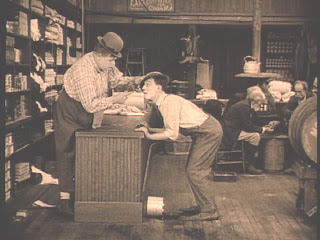Introduction
Comedian Paul Merton has had an interest in Silent Comedies since he was a teenager. DVD sales have provided access to these shorts for everyone, giving Merton a chance to create incredible documentaries on these topics. Only recently, he directed and presented a three-episode mini-series titled The Birth of Hollywood, whereby he managed to show how cinema was first born and, more importantly, how Hollywood began to dominate the market. I was utterly transfixed to this series when it played. Merton's enthusiasm and wide-knowledge of Silent Comedies was infectious and it was only a matter of time before I hunted down the celebrated comedies he noted in his documentary and book, Silent Comedy.
Buster Keaton Arrives
Beginning in 1917 is by no means the beginning of Silent Comedy. By this point, Charlie Chaplin was a household name - his 'tramp' character firmly established through his shorts The Tramp and The Vagabond. Roscoe 'Fatty' Arbuckle was well-known, now with the power to direct and headline his own films (The Butcher Boy is one of many "Roscoe 'Fatty' Arbuckle stars in The Butcher Boy". But this film did mark the first cinematic appearance of the unforgettable Buster Keaton. This is not an example of Buster Keaton before he became the deadpan, dry face of silent comedy. This is an incredibly self-assured start, whereby Keaton is ahead of his game when he filmed his first scene - which, proudly, Keaton acted in one-take.
From the Start
Buster Keaton was brought up on the road, his family were 'The Three Keatons' and their act consisted of much slap-stick comedy - whereby Buster would often be thrown around the stage by his Father, much to the delight of the audience. It was a chance meeting with Roscoe Arbuckle in New York which ensured Buster joined the Hollywood silent-comedy heroes. The difference between the Keystone cops and Charlie Chaplin's output at the time was immense - and The Butcher Boy shows a clear difference in comedy from the different actors. Buster Keaton's first gag shows him get caught on a tub of molasses (a honey-like by-product of processing sugar-cane). He hands the tub, with the money to Roscoe and asks for some molasses - Roscoe fills the tub up, on top of the money, only realising afterwards where the money is. Roscoe pours out the molasses into Keaton's hat, which resides, up-turned on the table, finds the money and Keaton picks up the hat, pops iit on his head and it is inevitably stuck. This well-thought out joke and planning is a far cry from the relentless throwing of flour that dominates the sequence and the bed-jumping and running-around and dog-biting finale that concludes the short. The Butcher Boy shows how certain comedians became so much more important than others - random tom-foolery would get a few laughs, but well thought-out, intelligently-planned comedy would always last the test of time.
Change of Scene
The film is set primarily in the butchers - whereby many customers create chaos as Arbuckle clumsily makes mistakes and creates gags in the process. We even see some brilliant use of a shapr knife as it appears Roscoe lets the huge knife slip out of his hand - only to land, blade stuck in, on the wooden surface. It happens once, and it looks like luck - shocking luck at that - but then it happens twice more and you realise that it is a skill. We also see some ridiculous sequences as the dog, Luke, runs on a home-made running-machine. Though it may be cruel - it is incredibly funny to see the dog running as fast as it can and getting nowhere. This whole sequence climaxes in thr aforementioned flour-fight, before suddenly changing direction to show Arbuckle attempt to win the love of Amanda by breaking into her all-female boarding school by dressing in drag. His rival, without knowing about Arbuckles plan, concocts the same plan giving us plenty of laughs when we see the two bumbling idiots feminise their characters.
Throughout all of this, Buster Keaton is in the background - not always as deadpan as he would later become - but definately in character. His physicality as he is pulled around and leaping across beds shows a real natural in his style and from this early cinematic-endeavour, Buster Keaton was clearly thr stand-out performance. Arbuckle had struck gold with this actor and the two continued to work together in the future - but, considering Keaton and Lloyd are often mentioned alongside Charlie Chaplin, at this moment in history Chaplin was towards the top of his game - and unknown to him Buster Keaton and Harold Lloyd were waiting in the wings to show something different. The Butcher Boy gives us a little tease about whats to come...



No comments:
Post a Comment
Copyright 2008-2015. All posts & reviews are property of www.simoncolumb.wordpress.com/Simon Columb and should not be reproduced in whole, or in part, without express permission from the author.